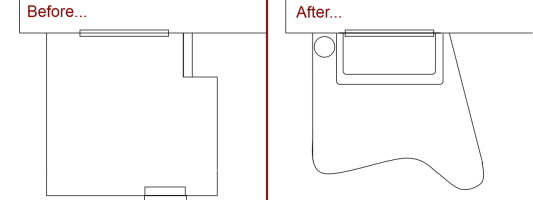Update: I found the pictures I was missing, so I've edited them in below (they were hiding on Facebook).
In my post on installing our rain barrel, I indicated that we now have a new patio. For a while we had wanted to remove our deck and replace it with a nice patio so it was exciting when we finally had enough money to get the job done.
Our fantastic neighbour, Tim, took charge on the project as our contractor and oversaw the effort of removing the deck and replacing it with a poured concrete patio. There were some issues we faced with the company responsible for pouring the concrete (if I could remember their name, I would tell you to avoid them, but I cannot right now), but Tim and I overcame those issues and he was able to get the patio finished.
The design for the patio was an amalgamation of ideas from myself, Chrissy and Tim. Here is a rough sketch to give you an idea of before and after (Tip: Make sure you have sketches, it will save time explaining what you want and help avoid conflict on the job). This does not show the height difference between the deck with its high railings and the patio. Also, this is not to scale, the patio is actually bigger than the deck, but my sketching abilities are inadequate.


Once the deck was removed (and some conflict had been ironed out over the shape), the patio and steps were framed and leveled ready for the concrete to be poured.

The concrete was coloured so that once finished, it would look somewhat stone-like. Once the concrete had time to dry, the framing was removed.

At this point, our neighbour took over and started to work on the finish. In the above photo, you may be able to just make out a grind stone which Tim used to slough off the rough burrs and blemishes so that we had a more appealing surface. He then applied a top coat to level out any big imperfections. Finally, two different colour powders were added to give more of a stone-effect before the whole thing was coated in a protective seal that also had gold flecks mixed in to catch the sunlight.
With the patio surface finished, Tim suggested we get some crushed concrete to pack around the patio, providing additional support and reducing the amount of space that would need filling with topsoil. Several tons of topsoil were distributed to landscape around the new patio. Although the patio was much lower than the deck (the deck had been at the same level as the back door), the slope of the back yard meant that the patio was up to 11 inches higher than the surround lawn in some areas. This meant that several cycles of dumping, raking and compacting soil were used to create a nice, sturdy transition from patio to lawn. In hindsight, I would have used more of the crushed concrete or some other filler and less topsoil, but it worked out.

While moving the soil around, we also added a new bed to the right of the backdoor and extended an existing bed on the far side of the patio to come around the front. They were covered with weed blocking membrane in preparation for plants. These are clearer to see in the next photo which was taken after I had sown grass seed.

While we waited for the grass to grow, we started work on the beds. A few plants were acquired from a vendor at Ann Arbor Farmers Market as well as some white marble chips to go around them. Unfortunately, we didn't really work the ground properly or put enough weed blocker down, so we now have white marble peppered with crab grass. In hindsight, we should have treated the soil with Round Up first (or a similar product) to kill everything before we put the weed blocker and marble down. New plants could have waited. Instead, we will be tasked with tearing up all the marble and weed blocker this spring or summer so that we can lay a thicker layer or perhaps, go the Round Up route if none of the new plants survived the winter.

I will perhaps go into the plants we got after they have had chance to attempt surviving their first Michigan winter (they just got reburied by snow this morning), until then, just know that they live (I think) as does the grass.

We are very happy with how this has turned out and look forward to getting some nice patio furniture for the summer (and maybe even a grill1). We might even have an English tea party to christen it.
- Barbecue for my non-American readers. [↩]
